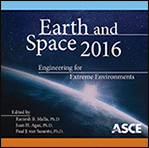15th Biennial ASCE Conference on Engineering, Science, Construction, and Operations in Challenging Environments
Design, Test, and Simulation of Lunar and Mars Landing Pad Soil Stabilization Built with In Situ Rock Utilization
Publication: Earth and Space 2016: Engineering for Extreme Environments
ABSTRACT
For repeated missions to develop infrastructure on the Moon and Mars, repeated visits to the same location will be required and landing pads will be a necessity. On the Moon these landing pads would prevent the regolith dust from sandblasting other infrastructure at 3 km/s and spreading dust all over the Moon and even into lunar orbit. On Mars the landing pads would prevent the lander exhaust plume from excavating a large hole under the lander, melting possible ice and possibly tipping the lander on its side resulting in damaging the lander. These landing pads would have to be built by robotic means before the human sized missions would arrive. To design these robots, it is necessary to determine what the landing pad could be made of and how they could be constructed. Various ISRU approaches have been suggested and studied for the center zone of the landing pad where the hot hyper velocity exhaust gases would contact the landing pad directly. A landing pad would provide a stable landing zone for touchdown of the lander and effective deflection of the exhaust plume without excavating a hole under the lander. This deflected (now horizontal flowing) plume would still scour the immediate area (secondary zone) next to the central landing zone and pick up the dust particles there. The secondary zone has a much larger surface area that needs to be stabilized and thus it would be beneficial to use in situ materials. Various options can be considered such as sintering, tiles, rock cover, and others. This paper will focus on tests performed on rock stabilized zones and their layering and on a method to model the in situ collected and constructed rock cover needed to lock in the regolith dust. The test setup, several tests and the results will be discussed. In addition, a first order model will be discussed to determine the maximum size rock needed to lock underlying layers in place during landing and take-off rocket exhaust plume loading cases.
Get full access to this article
View all available purchase options and get full access to this chapter.
REFERENCES
CUR, Manual on the use of rock in hydraulic engineering, Rotterdam; Brookfield, VT : A.A. Balkema, 1995
Lane, John E., and Philip T. Metzger, “Ballistics Model for Particles on a Horizontal Plane in a Vacuum Propelled by a Vertically Impinging Gas Jet,” Particle Science and Technology 30(2), 196-208 (2011).
Metzger, Philip T., Jacob Smith, and John E. Lane, “Phenomenology of Soil Erosion by Rocket Exhaust on the Moon and the Mauna Kea Lunar Analog Site,” Journal of Geophysical Research – Planets 116, E06005 (2011).
Metzger, Philip T., Xiaoyi Li, Christopher D. Immer, and John E. Lane, “ISRU Implications of Lunar and Martian Plume Effects,” AIAA 2009-1204, Proceedings of 47th AIAA Aerospace Sciences Conference, Orlando, FL, January 5-8, 2009.
Metzger, Philip T., and Robert P. Mueller, “Landing Plume Effects,” in Mars Design Reference Architecture 5.0, Addendum, NASA SP-2009-566-ADD pp. 234-248 (2009).
Morris, B., D. B. Goldstein, P. L. Varghese, and L. M. Trafton, “Plume Impingement on a Dusty Lunar Surface,” Rarefied Gas Dynamics, proceeding of the 27th International Symposium on Rarefied Gas Dynamics, Pacific Grove, CA., July, 2010.
Phillips, Paul G., et al., “Lunar Base Launch and Landing Facility Conceptual Design,”NASA contract NAS9-17878, EEI Report 88-178 (Webster, TX: Eagle Engineering, 1988).
Roberts, Leonard, “The Interaction of a Rocket Exhaust with the Lunar Surface,” The Fluid Dynamic Aspects of Space Flight v. 2 (New York: Gordon and Breach Science Publishers, 1966), pp. 269-290.
Sagan, C., Christopher Chyba, “Triton’s Streaks as Windblown Dust,” Nature 346, pp. 546-548 (1990).
Van der Meer, J.W.,“Stability of Breakwater Armour Layers – Design Formulae,” Coastal Engineering, Vol. 11, pp. 219-239, 1987
Van Susante, P.J., “Landing Pad Construction Rover Attachment Development,” in Proceedings of Earth and Space 2012 conference, ASCE pp. 165-174, Pasadena, CA, April 15-18, 2012
Information & Authors
Information
Published In
Earth and Space 2016: Engineering for Extreme Environments
Pages: 642 - 652
Editors: Ramesh B. Malla, Ph.D., University of Connecticut, Juan H. Agui, Ph.D., NASA Glenn Research Center, and Paul J. van Susante, Ph.D, Michigan Technological University
ISBN (Online): 978-0-7844-7997-1
Copyright
© 2016 American Society of Civil Engineers.
History
Published in print: Dec 30, 2016
Published online: Jun 29, 2017
Authors
Metrics & Citations
Metrics
Citations
Download citation
If you have the appropriate software installed, you can download article citation data to the citation manager of your choice. Simply select your manager software from the list below and click Download.
